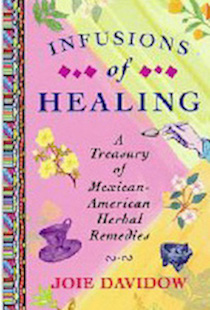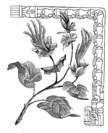Joie Davidow
Home - Biography - Books - Journalism - Appearances - Workshops - Editing Services - Contact
 Infusions of Healing:
Infusions of Healing:
A Treasury of Mexican-American Herbal Remedies
Fireside/Simon and Schuster 1999
From Mountain Valley Growers:
"Joie Davidow's telling of Aztec history is mesmerizing. When she draws her conclusion that had the Aztecs survived, their herbal medicines would rival those of the Chinese, I was totally convinced. Finding this book while looking for books on herbal tea was a stroke of luck. . . Easy to use and handy to have this book is also fascinating just to read."
Order from Bookshop.org
Order from Amazon
Order from Barnes and Noble
Excerpt
 From Chapter One: War of the Worlds
From Chapter One: War of the Worlds
When Cortés and his 553 men landed at Vera Cruz in 1519, they came face to face with a culture so vastly different from the one they had left in Europe, it was as though they had traveled by space ship to a distant galaxy. The people of the Aztec empire viewed reality from a perspective that was almost incomprehensible to the Spanish. And the Aztecs were equally confounded by the Spaniards, whom they regarding as half gods, half monsters. It could be argued that the more advanced culture lost the war, that the Spanish did not bring civilization to the New World, but effectively demolished it. The Aztecs reigned for little more than a century, but during those decades, through constant warfare that expanded the boundaries of the empire from the Gulf coast to the Pacific and trade routes that extended south through Honduras and Nicaragua, they acquired much of the collective knowledge of all the Mesoamerican peoples, inheriting the cultures of the Toltec, the Zapotec, the Mixtec, the Huaxtec, the Maya. They were extraordinary astronomers who had developed a yearly calendar accurate within eleven minutes, and charted the movements of the stars, using only their own eyes to scan the skies. They were advanced mathematicians, spectacular craftsmen, accomplished architects and engineers. The Aztecs were artists—musicians painters, sculptors, dancers. All members of the elite classes were poets. They valued skill with words as highly as skill with weapons and considered both to be necessary attributes. Vast libraries housed exquisitely painted fan-like volumes of fig bark paper in which they recorded their philosophy, history, religion, literature, law and scientific findings.
The conquistadors, marching into the Aztec capital of Tenochtitlan, were so overwhelmed by its splendor, they asked one another if they were dreaming. Crossing a wide causeway they entered a city of vast plazas, fountains, sculpture, architecture of heroic proportions brightly decorated with colorful murals and glyphs. Floating gardens swayed in the lagoon. Flowering vines cascaded over the terraces of the townhouses. In one of his historic long letters to the king of Spain, Cortés expressed fear that no one would believe his description of a city so full of wonder, that even the conquistadors themselves could hardly grasp what they were seeing. It has been called the Venice of the Americas, because like Venice, it was a magnificent city built on a series of canals. But it was more beautiful than Venice in one very important aspect. It was clean. So clean that a Spanish chronicler remarked that walking its streets he was “in no more danger of soiling his feet than he was of soiling his hands.” A thousand workers washed and swept the streets and plazas each day. Clean water was brought into the city through aqueducts. Human waste was picked up from the houses daily, and public toilet facilities were placed at intervals along the great causeways that led into the city. The Aztecs were meticulously clean in their person, as well. They were offended by body odor, bathed daily and used herbal deodorants and breath fresheners. Middle class houses had private bathrooms, and there were public bath houses throughout the city. Motecuhzoma II had more than a hundred bathrooms in his vast palace. He reportedly bathed and changed his clothes several times a day, never wearing a garment more than once.
The great capitals of Europe at that time, and for centuries afterwards, were full of filth and misery. The rat-infested alleys were strewn with garbage and human waste. Chamber pots were emptied onto the streets and clean running water was not even conceived of. The old adage that a man takes three baths in his lifetime, one at birth, one on his wedding day, and the last when he is a corpse about to be buried, was not far from the truth. The Spanish conquistadors were impressed that the Mexicans always greeted them by fumigating them with incense, which they took as great honor. But we can only imagine what these men, unwashed and sweating in their heavy clothing and armor, must have smelled like to their fastidious hosts. The Aztecs and the Spanish viewed one another with horror and awe, and each saw the face of a barbarian.